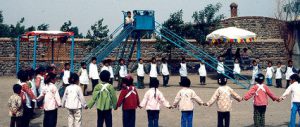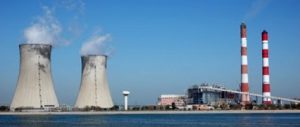It has been called the most toxic town in America, and now, less than 100 years after it received its charter from the state, it is being destroyed.
The tiny town of Picher sits just inside Oklahoma, near the border with Kansas, in the middle of the United States. Even at its peak, only about 25,000 people lived here, on land that once belonged to the Quapaw Indian tribe but was sold to mining companies in the late 1800s. Today, just a handful of people remain. House by house, the federal government has been buying up and destroying the buildings in order to facilitate an ambitious programme to rid the area of its toxic legacy.
Drive through Picher, and the first thing you will see are mountains, or what many new to the area believe to be mountains. But get a little closer and you discover that these mounds are, in fact, enormous piles of chat – rock laced with iron and lead.
These are the waste tailings left over from the area’s history of lead and zinc mining, dating back to the early 1900s. At its peak, Picher and its neighbouring towns had some of the highest lead and zinc production rates in the country, earning the states of Oklahoma, Kansas and Missouri the name Tri-State Mining District.
The mining companies operating here disposed of the chat by creating the large piles you see today, some as high as 61 metres. When the wind blows – which is often – the dust from the mounds stirs, pushing toxic materials into the air. According to the US Environmental Protection Agency (EPA), there are 83 chat piles here, covering an area of more than three square kilometres. There are also 243 chat “bases”, areas of ground previously occupied by chat piles, which cover an additional area of 8.4 square kilometres.
As well as the environmental and health hazards posed by the chat piles, the mines themselves have caused problems. When the mines were abandoned in the 1970s, they began to fill with water, and acid-laden liquid seeped into nearby Tar Creek, turning the water orange. When people dipped clothing into the water, it turned the cloth orange, too, recalled Kim Pace, a longtime Picher resident.
Pace, who is now 53 years old, remembers a happy childhood growing up in Picher. The chat piles, she said, were a part of everyday life. As the town began booming off the back of mineral production, houses, shops and even the school were built right next to the growing chat piles. “The chat piles were basically our friend,” she said. “People couldn’t ever figure out why the community was so close to them, but the community sprung up because of the chat piles.”
As an adult, Pace became a teacher at the local school and, around 1980, she began to notice problems among the students. “I couldn’t figure out what it was,” she said. “One day I would give them a passage and the next day they couldn’t read or understand it.”
The reason, it turned out, was elevated levels of lead in the children’s blood, caused by the dust blowing around the town. Some of the students recorded levels as high as 10 micrograms per decilitre, considered by experts to be a point at which damage to the brain and nervous system can occur. That, combined with mine-shaft hazards, soil contamination and other problems, led the EPA in 1983 to list Tar Creek and Picher on the National Priorities List – a list of sites eligible for long-term remedial clean-up, financed by central government under a programme called Superfund.
“The purpose of the response actions conducted at the Tar Creek site was to protect public health and welfare and the environment from releases or threatened releases of hazardous substances from the site,” the EPA wrote in a September 2005 report. “Discharges of acid mine water from the abandoned mines to surface water… threatened human health and the environment. In addition, exposure to lead contamination in residential soils was determined to be associated with human health risks higher than the acceptable range.”
Superfund, created in 1980, is the federal government programme to clean up hazardous waste sites across the country. As of November last year, there were 1,280 active Superfund sites in the United States, with 62 more proposed. Nearly 350 additional sites have been cleaned up and removed from the list.
According to Robert Collin, an adjunct professor of law at Willamette University College of Law in the north-western state of Oregon, the Superfund list is exciting and pioneering, but riddled with problems: “It is an unavoidable policy step fraught with many errors in the first phases of implementation,” he said. Collin believes that every state and city in the country should have its own programme like this, because all environmental decisions are local when implemented.
When it comes to clean-ups, the controversy usually centres around the question “How clean?” said Collin.
Picher is a case in point. At first, the government planned only to clean up residents’ yards, removing waste that was potentially hazardous. But in 2003, the EPA, in cooperation with local environmental departments, created a final clean-up plan, which called for voluntary buyouts and destruction of properties through the State of Oklahoma’s Lead-Impacted Communities Relocation Assistance Trust.
The buyouts began in 2005 with families with children under the age of six in Picher and surrounding towns, but eventually came to include all residents. Locals taking part in the first round of buyouts received offers of US$37 (243 yuan) per square foot (0.09 square metres), which worked out at an average of around US$54,000 (354,000 yuan) per house. Residents in the second round were offered US$52 (341 yuan) per square foot, or US$65,624 (431,000 yuan) per house, on average.
By May 2010, everyone who once lived in Picher was gone, save for four families – two with children – who did not accept the voluntary buyout because they did not want to move and start over, according to Pace. Destruction of buildings has begun and is anticipated to end in December this year. Altogether, more than 750 homes and businesses were bought out for a total of US$46 million (302 million yuan).
Since the 1970s, dozens of communities near contaminated sites across the United States have been bought up by the federal government, state and local governments, or by companies found to have caused pollution. Most recently, some residents of Pompton Lakes in New Jersey, a state on the east coast, have stated that they want their homes bought out after it was discovered a DuPont factory was polluting nearby groundwater with the cancer-causing solvents trichloroethylene (TCE) and perchloroethene (PCE).
A 2010 US Government and Accountability report showed the potential economic shortfalls of the Superfund programme. By the end of the 2009 financial year, the EPA had expended US$3 billion (19.7 billion yuan) on just 75 sites with unacceptable human exposure and US$1.2 billion (7.9 billion yuan) on 164 non-federal sites with unknown exposure. According to the report, “EPA’s future costs to conduct remedial construction at nonfederal NPL sites will likely exceed recent funding levels.”
Officials estimate that the EPA’s costs will range from US$335 million (2.2 billion yuan) to US$681 million (4.5 billion yuan) each year for the years 2010 to 2014, which will exceed the US$220 million (1.5 billion yuan) to US$267 million (1.8 billion yuan) that the EPA allocated annually for remedial actions between 2000 and 2009.
Moreover, it says these figures are likely to be underestimates, because they do not include costs for sites that are early in the clean-up process or where a responsible party is currently funding remedial construction but may be unable to do so in the future. EPA officials also say that actual costs are often higher than initial estimates because contamination tends to be greater than initially thought.
As long as private companies, as well as central, state and local governments, continue to pollute first and hope to remedy the problem later, the federal government will continue to exceed the money available, eventually reaching the point where there is no budget for clean-up efforts and citizens are left to suffer the consequences of living with environmental and health hazards.
Kristi Eaton is a freelance journalist based in Oklahoma.
Homepage image from The Picher Oklahoma group


